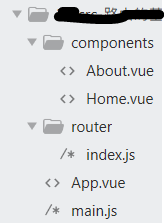文章目录
Vue路由
理解: 一个路由(route)就是一组映射关系(key - value),key 为路径, value 可能是 function 或 component;多个路由需要路由器(router)进行管理。
路由分类:
- 后端路由:
理解:value 是 function, 用于处理客户端提交的请求。
工作过程:服务器接收到一个请求时, 根据请求路径找到匹配的函数来处理请求, 返回响应数据。 - 前端路由:
理解:value 是 component,用于展示页面内容。
工作过程:当浏览器的路径改变时, 对应的组件就会显示。
vue-router是vue 的一个插件库,专门用来实现 SPA 应用。
SPA 应用:
- 单页 Web 应用(single page web application,SPA)。
- 整个应用只有一个完整的页面。
- 点击页面中的导航链接不会刷新页面,只会做页面的局部更新。
- 数据需要通过 ajax 请求获取。
1.基本使用
-
安装vue-router,命令:
npm i vue-router -
应用插件:
Vue.use(VueRouter)
main.js:
//引入Vue
import Vue from 'vue'
//引入App
import App from './App.vue'
//引入VueRouter
import VueRouter from 'vue-router'
//引入路由器
import router from './router'//因为router目录下仅一个文件所以/index.js可省略
//应用插件
Vue.use(VueRouter)
//创建vm
new Vue({
el:'#app',
render: h => h(App),
router:router
})
- 编写router配置项:
src/router/index.js:
//引入VueRouter
import VueRouter from 'vue-router'
//引入Luyou 组件
import About from '../components/About'
import Home from '../components/Home'
//创建router实例对象,去管理一组一组的路由规则
const router = new VueRouter({
routes:[
{
path:'/about',
component:About
},
{
path:'/home',
component:Home
}
]
})
//暴露router
export default router
-
实现切换(active-class可配置高亮样式)
<router-link active-class="active" to="/about">About</router-link>//router-link会被转换为a标签,active-class表示被选中是类名为active -
指定组件的展示位置
<router-view></router-view>
App.vue:
<template>
<div>
<div class="row">
<div class="col-xs-offset-2 col-xs-8">
<div class="page-header"><h2>Vue Router Demo</h2></div>
</div>
</div>
<div class="row">
<div class="col-xs-2 col-xs-offset-2">
<div class="list-group">
<!-- 原始html中我们使用a标签实现页面的跳转 -->
<!-- <a class="list-group-item active" href="./about.html">About</a> -->
<!-- <a class="list-group-item" href="./home.html">Home</a> -->
<!-- Vue中借助router-link标签实现路由的切换 -->
<router-link class="list-group-item" active-class="active" to="/about">About</router-link>
<router-link class="list-group-item" active-class="active" to="/home">Home</router-link>
</div>
</div>
<div class="col-xs-6">
<div class="panel">
<div class="panel-body">
<!-- 指定组件的呈现位置 -->
<router-view></router-view>
</div>
</div>
</div>
</div>
</div>
</template>
<script>
export default {
name:'App',
}
</script>
About.vue:
<template>
<h2>我是About的内容</h2>
</template>
<script>
export default {
name:'About'
}//Home.vue同理
</script>

2.几个注意点
- 路由组件通常存放在
pages文件夹,一般组件通常存放在components文件夹。 - 通过切换,“隐藏”了的路由组件,默认是被销毁掉的,需要的时候再去挂载。
- 每个组件都有自己的
$route属性,里面存储着自己的路由信息。 - 整个应用只有一个router,可以通过组件的
$router属性获取到。
3.嵌套(多级)路由
-
配置路由规则,使用children配置项:
routes:[ { path:'/about', component:About, }, { path:'/home', component:Home, children:[ //通过children配置子级路由 { path:'news', //子路由此处一定不要写:/news component:News }, { path:'message',//此处一定不要写:/message component:Message } ] } ] -
跳转(二级路由要写完整路径,带上父亲):
<router-link to="/home/news">News</router-link>
4.路由的query参数
-
传递参数:
<!-- 跳转并携带query参数,to的字符串写法 --> <!-- <router-link :to="`/home/message/detail?id=${m.id}&title=${m.title}`">{{m.title}}</router-link> --> <!-- 跳转并携带query参数,to的对象写法(推荐) --> <router-link :to="{ path:'/home/message/detail', query:{ id:m.id, title:m.title } }"> {{m.title}} </router-link> -
接收参数:
<template> <ul> <li>消息编号:{{$route.query.id}}</li> <li>消息标题:{{$route.query.title}}</li> </ul> </template>
5.命名路由
-
作用:可以简化路由的跳转。
-
如何使用
-
给路由命名:
routes:[{ path:'/demo', component:Demo, children:[ { name:'ceshi', path:'test', component:Test, children:[ { name:'hello' //给路由命名 path:'welcome', component:Hello, } ] } ] }] -
简化跳转:
<!--简化前,需要写完整的路径 --> <router-link to="/demo/test/welcome">跳转</router-link> <!--简化后,直接通过名字跳转 --> <router-link :to="{name:'hello'}">跳转</router-link> <!--简化写法配合传递参数 --> <router-link :to="{ //path:'/demo/test/welcome'//写了namepath就可以省略了 name:'hello', query:{ id:666, title:'你好' } }" >跳转</router-link>
-
6.路由的params参数
-
配置路由,声明接收params参数
{ path:'/home', component:Home, children:[ { path:'news', component:News }, { component:Message, children:[ { name:'xiangqing', path:'detail/:id/:title', //使用占位符声明接收params参数 component:Detail } ] } ] } -
传递参数
<!-- 跳转并携带params参数,to的字符串写法 --> <!-- <router-link :to="`/home/message/detail/${m.id}/${m.title}`">{{m.title}}</router-link> --> <!-- 跳转并携带params参数,to的对象写法 --> <router-link :to="{ name:'xiangqing', params:{ id:m.id, title:m.title } }"> {{m.title}} </router-link>特别注意:路由携带params参数时,若使用to的对象写法,则不能使用path配置项,必须使用name配置!
-
接收参数:
$route.params.id $route.params.title
7.路由的props配置
? 作用:让路由组件更方便的收到参数,直接写个{{id}}就行了。
- 第一种写法:props值为对象,该对象中所有的key-value的组合最终都会通过props传给Detail组件。(用的少,死数据)
{
name:'xiangqing',
path:'detail/:id/:title',
component:Detail,
props:{a:900,b:600}
}
Detail.vue:
<template>
<ul>
<li>a:{{a}}</li>
<li>b:{{b}}</li>
</ul>
</template>
<script>
export default {
name:'Detail',
props:['a','b'],
}
</script>
- 第二种写法:props值为布尔值,布尔值为true,则把路由收到的所有params参数通过props传给Detail组件。
{
name:'xiangqing',
path:'detail/:id/:title',
component:Detail,
props:true
}
Detail.vue:
<template>
<ul>
<li>消息编号:{{id}}</li>
<li>消息标题:{{title}}</li>
</ul>
</template>
<script>
export default {
name:'Detail',
props:['id','title'],
}
</script>
- 第三种写法:props值为函数,该函数返回的对象中每一组key-value都会通过props传给Detail组件。
{
name:'xiangqing',
path:'detail',
component:Detail,
props($route){
return {
id:$route.query.id,
title:$route.query.title
}
}
}
Detail.vue:
<template>
<ul>
<li>消息编号:{{id}}</li>
<li>消息标题:{{title}}</li>
</ul>
</template>
<script>
export default {
name:'Detail',
props:['id','title'],
}
</script>
8.<router-link>的replace属性
- 作用:控制路由跳转时操作浏览器历史记录的模式
- 浏览器的历史记录有两种写入方式:分别为
push和replace,push是追加历史记录,即浏览器可前进后退,replace是替换当前记录。路由跳转时候默认为push - 如何开启
replace模式:<router-link replace .......>News</router-link>或<router-link :replace="true" .......>News</router-link>
9.编程式路由导航
-
作用:不借助
<router-link>实现路由跳转,让路由跳转更加灵活 -
具体编码:
//$router的两个API,参数内容和<router-link>的:to里的一样 this.$router.push({//有记录的跳转 name:'xiangqing', params:{ id:xxx, title:xxx } }) this.$router.replace({//替换当前记录的跳转 name:'xiangqing', params:{ id:xxx, title:xxx } }) this.$router.forward() //前进 this.$router.back() //后退 this.$router.go() //可前进也可后退,括号里的数是3则前进3步,-2则是后退2步。
使用示例:
<li v-for="m in messageList" :key="m.id">
<button @click="pushShow(m)">push查看</button>
<button @click="replaceShow(m)">replace查看</button>
</li>
<button @click="back">后退</button>
<button @click="forward">前进</button>
<button @click="test">测试一下go</button>
<script>
export default {
name:'Message',
data() {
return {
messageList:[
{id:'001',title:'消息001'},
{id:'002',title:'消息002'},
{id:'003',title:'消息003'}
]
}
},
methods: {
pushShow(m){
this.$router.push({
name:'xiangqing',
query:{
id:m.id,
title:m.title
}
})
},
replaceShow(m){
this.$router.replace({
name:'xiangqing',
query:{
id:m.id,
title:m.title
}
})
}
back(){
this.$router.back()
// console.log(this.$router)
},
forward(){
this.$router.forward()
},
test(){
this.$router.go(3)
}
},
}
</script>
10.缓存路由组件
-
作用:让不展示的路由组件保持挂载,不被销毁,因为有的数据需要保留,再返回时数据还在。
-
具体编码:
<!-- 缓存多个路由组件 --> <!-- <keep-alive :include="['News','Message']"> --> <!-- 缓存一个路由组件 --> <keep-alive include="News"> 若不写include="News"则keep-alive里面所有都被缓存不被销毁 <router-view></router-view>//要展示的router-view外包裹keep-alive </keep-alive>
export default {
name:'News'//include="News"里的News要保持挂载的组件名,这要是改名,则include里的要跟着改
}
11.两个新的生命周期钩子
- 作用:路由组件所独有的两个钩子,用于捕获路由组件的激活状态。
- 具体名字:
activated路由组件被激活时触发。deactivated路由组件失活时触发。
12.路由守卫
-
作用:对路由进行权限控制
-
分类:全局守卫、独享守卫、组件内守卫
-
全局守卫:
//src/router/index.js const router = new VueRouter({ routes:[ { name:'guanyu', path:'/about', component:About, meta:{title:'关于'} }, { name:'zhuye', path:'/home', component:Home, meta:{title:'主页'}, children:[ { name:'xinwen', path:'news', component:News, meta:{isAuth:true,title:'新闻'}//meta里写自定义的路由元信息 }, { name:'xiaoxi', path:'message', component:Message, meta:{isAuth:true,title:'消息'}, children:[ { name:'xiangqing', path:'detail', component:Detail, meta:{isAuth:true,title:'详情'}, } ] } ] } ] }) //全局前置守卫:初始化时执行、每次路由切换前执行 router.beforeEach((to,from,next)=>{ console.log('beforeEach',to,from) if(to.meta.isAuth){ //判断当前路由是否需要进行权限控制(提前在上边给需要进行权限控制的配置个isAuth属性) if(localStorage.getItem('school') === 'qinghua'){ //权限控制的具体规则 next() //放行,显示要切换的组件 }else{ alert('暂无权限查看') // next({name:'guanyu'}) } }else{ next() //放行 } }) //全局后置守卫:初始化时执行、每次路由切换后执行 router.afterEach((to,from)=>{ console.log('afterEach',to,from) document.title = to.meta.title ||"主页"//修改网页的title }) -
独享守卫:
{ name:'xinwen', path:'news', component:News, meta:{isAuth:true,title:'新闻'}, beforeEnter(to,from,next){//仅对这一个路由做出限制,没有afterEnter() console.log('beforeEnter',to,from) if(to.meta.isAuth){ //判断当前路由是否需要进行权限控制 if(localStorage.getItem('school') === 'atguigu'){ next() }else{ alert('暂无权限查看') // next({name:'guanyu'}) } }else{ next() } } } -
组件内守卫:(前几种都写在src/router/index.js,而这个要写在具体组件中)
//进入守卫:通过路由规则,进入该组件时被调用 beforeRouteEnter (to, from, next) { ...... next() }, //离开守卫:通过路由规则,离开该组件时被调用 beforeRouteLeave (to, from, next) {//与全局后置守卫afterEach(进入该组件后调用)不同 ...... next() }
13.路由器的两种工作模式
- 对于一个url来说,hash值就是 #及其后面的内容就是hash值。
- hash值不会包含在 HTTP 请求中,即:hash值不会带给服务器。
- hash模式:(默认)
- 地址中永远带着#号,不美观 。e.g.:
localhost:8080/#/home/message - 若以后将地址通过第三方手机app分享,若app校验严格,则地址会被标记为不合法。
- 兼容性较好。
- 地址中永远带着#号,不美观 。e.g.:
- history模式:在路由配置中写:
mode:'history'- 地址干净,美观 。
- 兼容性和hash模式相比略差。
- 应用部署上线时需要后端人员支持,解决刷新页面服务端404的问题。
Vue项目打包:执行npm run build会生成一个dist文件夹,它把所有东西都转换成html、css、js等静态资源,然后将其中所有内容拖到服务器目录便可运行访问。